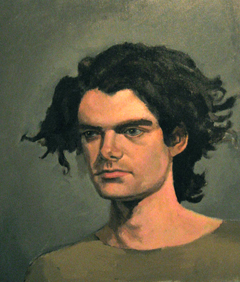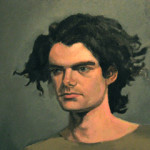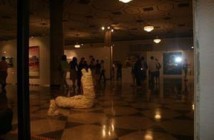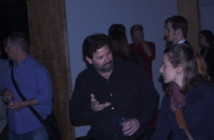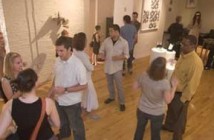The message is on the wall, in the yellow rectangle drawn around the eleven oil portraits on panel. Jeffrey Ellse’s art is trapped in rectangles. His art expresses a fear of expression. Psychological barricades are erected in a few thick strokes of Howie's hair that give the model a nonchalant, contemptuous attitude. Most of the posers have tightly compressed lips and sad, foggy eyes. A nude torso of Jeff’s fiancé, Colleen is facing away, but her face is looking at us. Like the rest, her eyes hold a flirtatious sorrow, as if she knows that she is only a painting, and that she cannot speak, express or move. “Why did you paint me?” it seems to ask. “I could have said and done so much on film.”
Ellse told me about his artistic motivations during a private tour of the MFA, where he works as a full-time security guard. When asked why he chose realism Ellse says that it was a more natural medium for him. But the real answer lies in stories from his youth. They strike like flashes from a nightmarish, rocking, partying and hungrily exploring life. He gouache painted stuffed birds almost every Thursday for a year at the Museum of Natural History at Harvard until he got kicked out. Why sit through a year of repetitive painting on the same subject? And why dead birds? The dead can’t speak or move. Instead, a dead subject is preferential because it remains docile to study – immobile forever.
Ellse’s friend and model Howie Jones is a wedding photographer, and a co-worker at the MFA. In his photography, Howie especially likes to surprise people in the middle of natural actions. Unlike Ellse, Howie does not need a dead model to capture its detailed essence. He can throw sticks in the air and photograph them fall. Mobility makes photographed subjects more expressive. Ellse stares at subjects for hours to portray them. And if a subject moves, even just an eyebrow, the painting is adversely affected. The artist has to adjust proportions to fit with the change. Instability is a dangerous quality for this painter.
Ellse also performs with the experimental rock band, The Globs. For one of their shows he hid inside of a large egg, or a “water planet,” and in the finale jumped out, broke it and was re-born through the egg, covered in spaghetti sauce, wearing Sponge Bob boxers. “[I was] cold, heavy, smelled awful. The sauce got crusty. I put it on too early. I was sitting for forty minutes in [the egg]. I liked it – like meditation.” Meditation and patience are the main ingredients in Ellse's realism. When he is drawing he is sitting in a giant egg of restraint, listening to the sitter’s mood, and waiting to withdraw as soon as the painting is finished. Artistic technique is a game of patiently waiting inside of an egg, withholding uncontrolled emotional outbursts. “I like the amount of craft Jeff puts into his art – most people are more into conceptual art – don’t put in enough time for realism,” Howie commented.
But is Ellse focusing on expressing through technique, or is he distracted in an airy, drunken stupor? On a camping trip a few weeks ago he had trouble painting because he was, “drinking a lot of beer.” But Howie is quick to add that for Jeff there was “no heroin phase.” He camps, drinks and leads the life-style of what can be termed “college, party boy.” Still he paints the details of ear spirals and nose bumps with diligence. According to Howie, the college-culture encourages students to turn in their work quickly, and stresses “immediate results.” Patience, or “putting in decades into learning the craft,” is missing. “They (modern artists, like Andy Warhol) want to make it while they’re still young.” Michal Opalski, an artist visiting the Tufts gallery, gave a different spin to the question. “It can take years to master painting technically – it’s still boring. You can be the best portrait painter but have nothing to say. It doesn’t make me interested in those people.”
Though his work doesn't appeal to everyone, Ellse’s life inspires observation. He won second place at a Taiji Legacy, San Shou martial arts competition. Howie explains that both fighting and painting require, “muscle memory.” Ellse explains, “Martial arts made me realize that I should be painting… that martial arts aren’t the way.” Are the tears in the eyes of the models reflections of “the way” or the soul, or are they glittering white paintbrush strokes? Can a martial art move or a brush stroke express “something beyond appearance?"
Nicholas Stedman, an art school student commented, “I like [the paintings], but also, I’m not sure I get it. Feels more like a painting than an impression of an actual person.”
In a statement about his work Ellse writes, "Truth is important in my paintings... In everyday life, people like to believe certain things about themselves and often ignore the obvious."
Few things are obvious about Ellse. His realism is so inexpressive that he leaves his viewers with many questions, without digested conclusions.
His Ma has unnaturally red lips and black eyelashes. From this, viewers know that the model had too much makeup on. Her shoulders slouch, and we assume that she is tired. We don’t know Ma. We can’t ask her why she is slouching or why she is wearing so much makeup. She appears to be tired, but “exhaustion” isn’t written on her forehead. Her red lips are sealed and unless we ask Jeff Ellse about her, we only see a reproduction of a dead moment.
Links:
Tufts University Art Gallery
"The Third Annual Summer Exhibition" is on view until July 30th at the Tufts University Art Gallery.
All images are courtesy of the artist and Tufts University Art Gallery.

